Evaluating Accounting Policies and Standards in Qantas Airways Report
VerifiedAdded on 2023/06/12
|6
|1432
|209
Report
AI Summary
This report provides a detailed analysis and interpretation of the accounting policies and procedures employed by Qantas Airways, Australia's national carrier, as presented in its annual report. It examines the company's adherence to the Australian Accounting Standards Board (AASB) and the Corporations Act 2001, focusing on the consistency of these policies with accounting standards related to assets, liabilities, equity, revenue, and expenses. The report also addresses changes in accounting standards, such as IFRS 7 and IAS 1, and their impact on Qantas' financial reporting. Furthermore, it explores the connection between the company's accounting policies and its overall business strategy, emphasizing the importance of transparency and high-quality financial reporting in supporting stakeholder decision-making and sustainable growth. The report concludes that Qantas Airways' accounting policies align with AASB standards, ensuring reliable and decision-useful financial information.
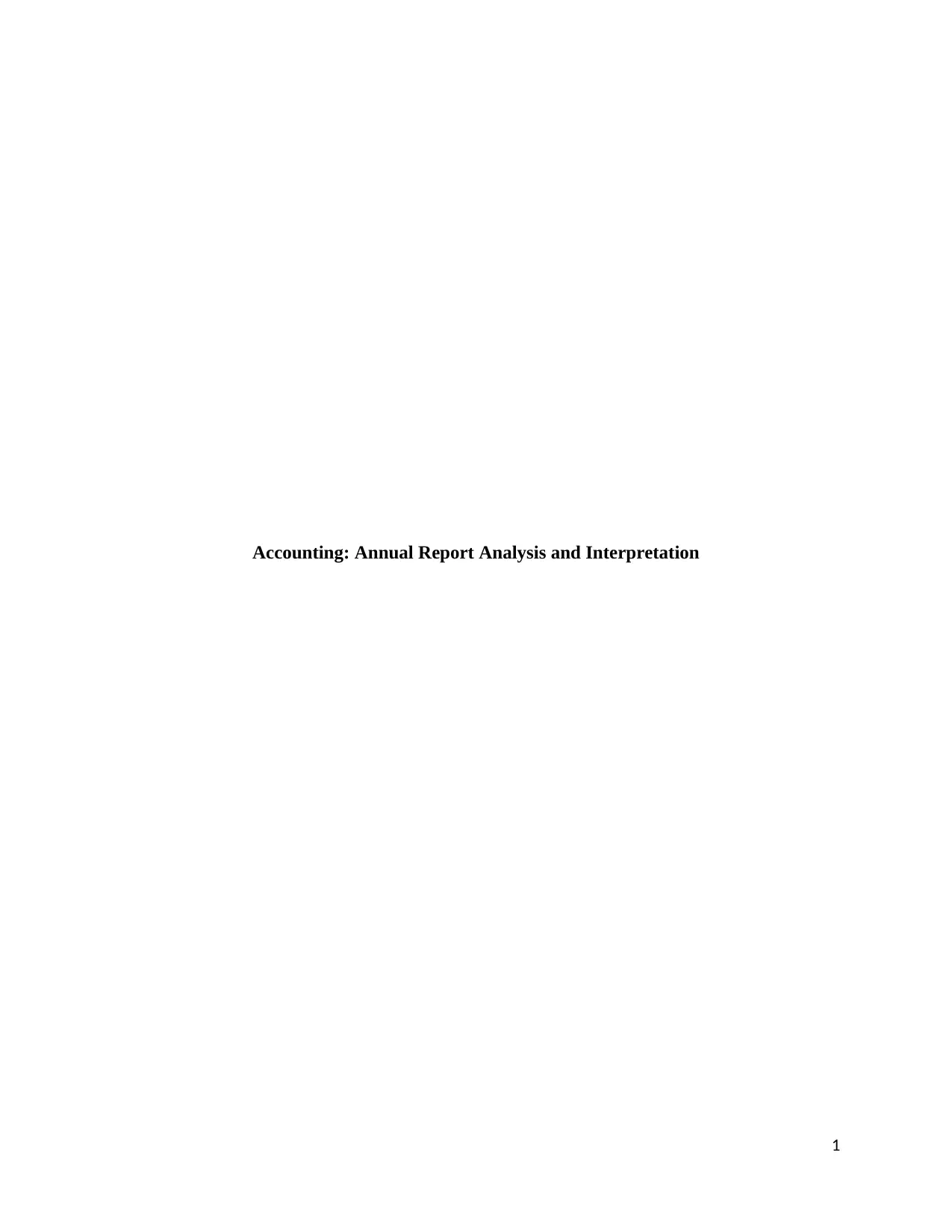
Accounting: Annual Report Analysis and Interpretation
1
1
Paraphrase This Document
Need a fresh take? Get an instant paraphrase of this document with our AI Paraphraser
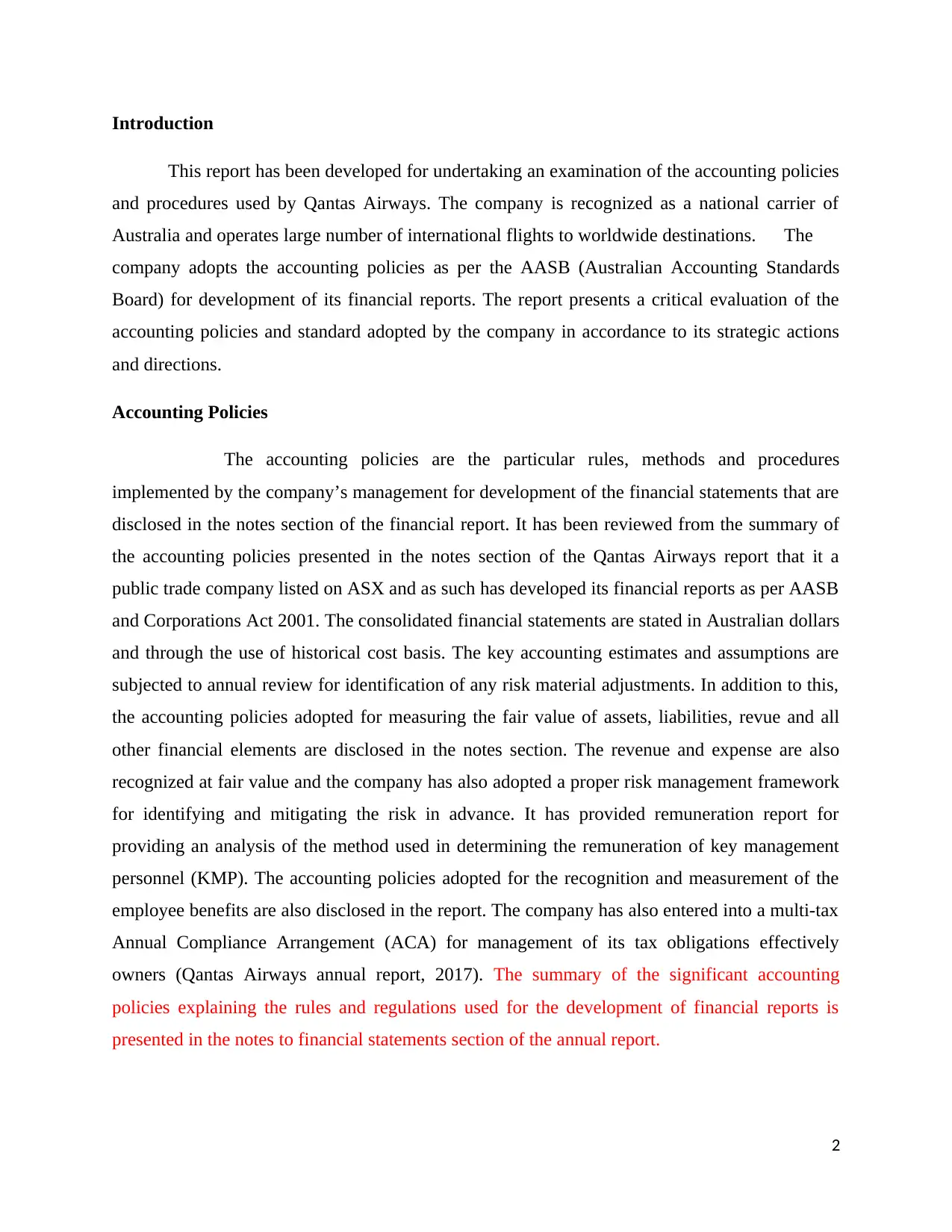
Introduction
This report has been developed for undertaking an examination of the accounting policies
and procedures used by Qantas Airways. The company is recognized as a national carrier of
Australia and operates large number of international flights to worldwide destinations. The
company adopts the accounting policies as per the AASB (Australian Accounting Standards
Board) for development of its financial reports. The report presents a critical evaluation of the
accounting policies and standard adopted by the company in accordance to its strategic actions
and directions.
Accounting Policies
The accounting policies are the particular rules, methods and procedures
implemented by the company’s management for development of the financial statements that are
disclosed in the notes section of the financial report. It has been reviewed from the summary of
the accounting policies presented in the notes section of the Qantas Airways report that it a
public trade company listed on ASX and as such has developed its financial reports as per AASB
and Corporations Act 2001. The consolidated financial statements are stated in Australian dollars
and through the use of historical cost basis. The key accounting estimates and assumptions are
subjected to annual review for identification of any risk material adjustments. In addition to this,
the accounting policies adopted for measuring the fair value of assets, liabilities, revue and all
other financial elements are disclosed in the notes section. The revenue and expense are also
recognized at fair value and the company has also adopted a proper risk management framework
for identifying and mitigating the risk in advance. It has provided remuneration report for
providing an analysis of the method used in determining the remuneration of key management
personnel (KMP). The accounting policies adopted for the recognition and measurement of the
employee benefits are also disclosed in the report. The company has also entered into a multi-tax
Annual Compliance Arrangement (ACA) for management of its tax obligations effectively
owners (Qantas Airways annual report, 2017). The summary of the significant accounting
policies explaining the rules and regulations used for the development of financial reports is
presented in the notes to financial statements section of the annual report.
2
This report has been developed for undertaking an examination of the accounting policies
and procedures used by Qantas Airways. The company is recognized as a national carrier of
Australia and operates large number of international flights to worldwide destinations. The
company adopts the accounting policies as per the AASB (Australian Accounting Standards
Board) for development of its financial reports. The report presents a critical evaluation of the
accounting policies and standard adopted by the company in accordance to its strategic actions
and directions.
Accounting Policies
The accounting policies are the particular rules, methods and procedures
implemented by the company’s management for development of the financial statements that are
disclosed in the notes section of the financial report. It has been reviewed from the summary of
the accounting policies presented in the notes section of the Qantas Airways report that it a
public trade company listed on ASX and as such has developed its financial reports as per AASB
and Corporations Act 2001. The consolidated financial statements are stated in Australian dollars
and through the use of historical cost basis. The key accounting estimates and assumptions are
subjected to annual review for identification of any risk material adjustments. In addition to this,
the accounting policies adopted for measuring the fair value of assets, liabilities, revue and all
other financial elements are disclosed in the notes section. The revenue and expense are also
recognized at fair value and the company has also adopted a proper risk management framework
for identifying and mitigating the risk in advance. It has provided remuneration report for
providing an analysis of the method used in determining the remuneration of key management
personnel (KMP). The accounting policies adopted for the recognition and measurement of the
employee benefits are also disclosed in the report. The company has also entered into a multi-tax
Annual Compliance Arrangement (ACA) for management of its tax obligations effectively
owners (Qantas Airways annual report, 2017). The summary of the significant accounting
policies explaining the rules and regulations used for the development of financial reports is
presented in the notes to financial statements section of the annual report.
2
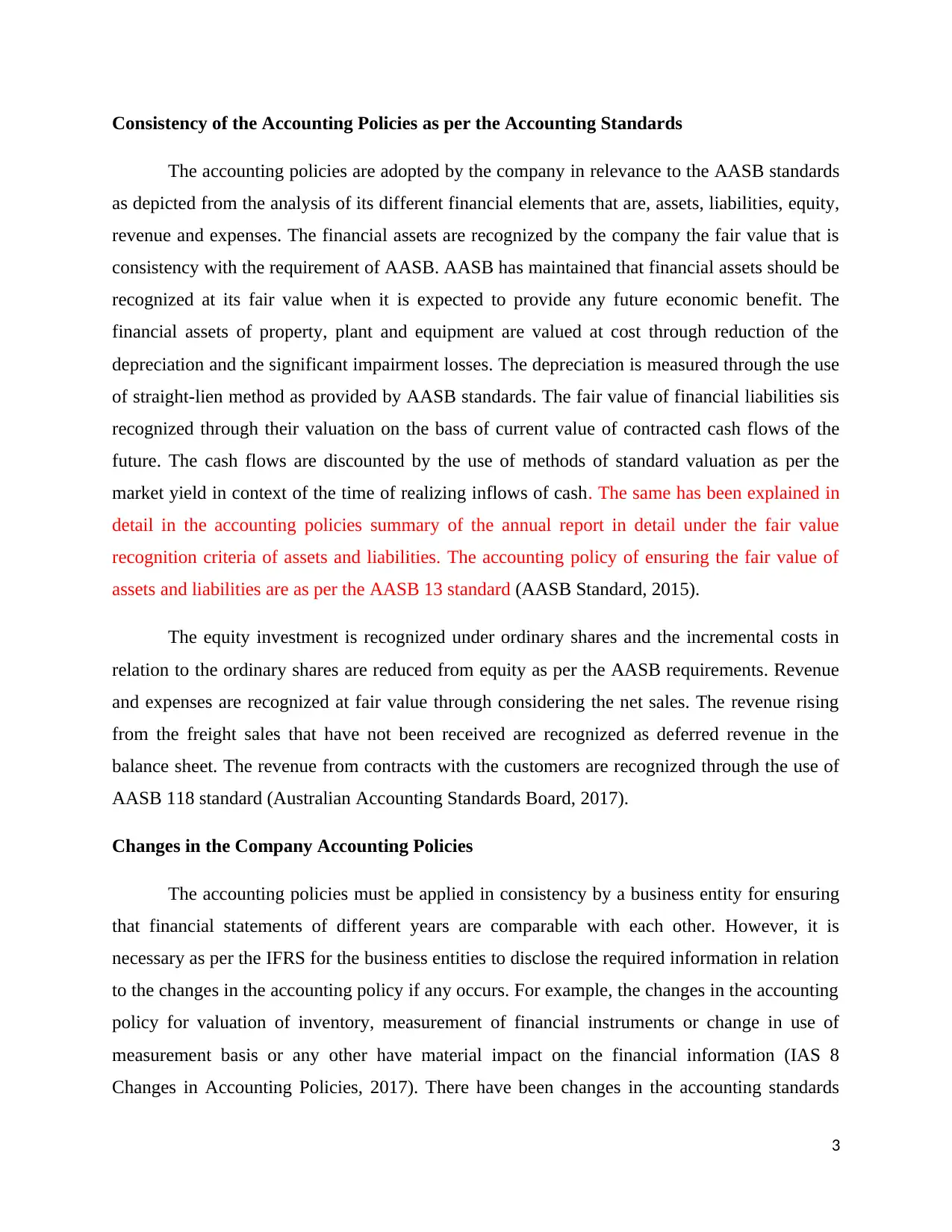
Consistency of the Accounting Policies as per the Accounting Standards
The accounting policies are adopted by the company in relevance to the AASB standards
as depicted from the analysis of its different financial elements that are, assets, liabilities, equity,
revenue and expenses. The financial assets are recognized by the company the fair value that is
consistency with the requirement of AASB. AASB has maintained that financial assets should be
recognized at its fair value when it is expected to provide any future economic benefit. The
financial assets of property, plant and equipment are valued at cost through reduction of the
depreciation and the significant impairment losses. The depreciation is measured through the use
of straight-lien method as provided by AASB standards. The fair value of financial liabilities sis
recognized through their valuation on the bass of current value of contracted cash flows of the
future. The cash flows are discounted by the use of methods of standard valuation as per the
market yield in context of the time of realizing inflows of cash. The same has been explained in
detail in the accounting policies summary of the annual report in detail under the fair value
recognition criteria of assets and liabilities. The accounting policy of ensuring the fair value of
assets and liabilities are as per the AASB 13 standard (AASB Standard, 2015).
The equity investment is recognized under ordinary shares and the incremental costs in
relation to the ordinary shares are reduced from equity as per the AASB requirements. Revenue
and expenses are recognized at fair value through considering the net sales. The revenue rising
from the freight sales that have not been received are recognized as deferred revenue in the
balance sheet. The revenue from contracts with the customers are recognized through the use of
AASB 118 standard (Australian Accounting Standards Board, 2017).
Changes in the Company Accounting Policies
The accounting policies must be applied in consistency by a business entity for ensuring
that financial statements of different years are comparable with each other. However, it is
necessary as per the IFRS for the business entities to disclose the required information in relation
to the changes in the accounting policy if any occurs. For example, the changes in the accounting
policy for valuation of inventory, measurement of financial instruments or change in use of
measurement basis or any other have material impact on the financial information (IAS 8
Changes in Accounting Policies, 2017). There have been changes in the accounting standards
3
The accounting policies are adopted by the company in relevance to the AASB standards
as depicted from the analysis of its different financial elements that are, assets, liabilities, equity,
revenue and expenses. The financial assets are recognized by the company the fair value that is
consistency with the requirement of AASB. AASB has maintained that financial assets should be
recognized at its fair value when it is expected to provide any future economic benefit. The
financial assets of property, plant and equipment are valued at cost through reduction of the
depreciation and the significant impairment losses. The depreciation is measured through the use
of straight-lien method as provided by AASB standards. The fair value of financial liabilities sis
recognized through their valuation on the bass of current value of contracted cash flows of the
future. The cash flows are discounted by the use of methods of standard valuation as per the
market yield in context of the time of realizing inflows of cash. The same has been explained in
detail in the accounting policies summary of the annual report in detail under the fair value
recognition criteria of assets and liabilities. The accounting policy of ensuring the fair value of
assets and liabilities are as per the AASB 13 standard (AASB Standard, 2015).
The equity investment is recognized under ordinary shares and the incremental costs in
relation to the ordinary shares are reduced from equity as per the AASB requirements. Revenue
and expenses are recognized at fair value through considering the net sales. The revenue rising
from the freight sales that have not been received are recognized as deferred revenue in the
balance sheet. The revenue from contracts with the customers are recognized through the use of
AASB 118 standard (Australian Accounting Standards Board, 2017).
Changes in the Company Accounting Policies
The accounting policies must be applied in consistency by a business entity for ensuring
that financial statements of different years are comparable with each other. However, it is
necessary as per the IFRS for the business entities to disclose the required information in relation
to the changes in the accounting policy if any occurs. For example, the changes in the accounting
policy for valuation of inventory, measurement of financial instruments or change in use of
measurement basis or any other have material impact on the financial information (IAS 8
Changes in Accounting Policies, 2017). There have been changes in the accounting standards
3
⊘ This is a preview!⊘
Do you want full access?
Subscribe today to unlock all pages.

Trusted by 1+ million students worldwide
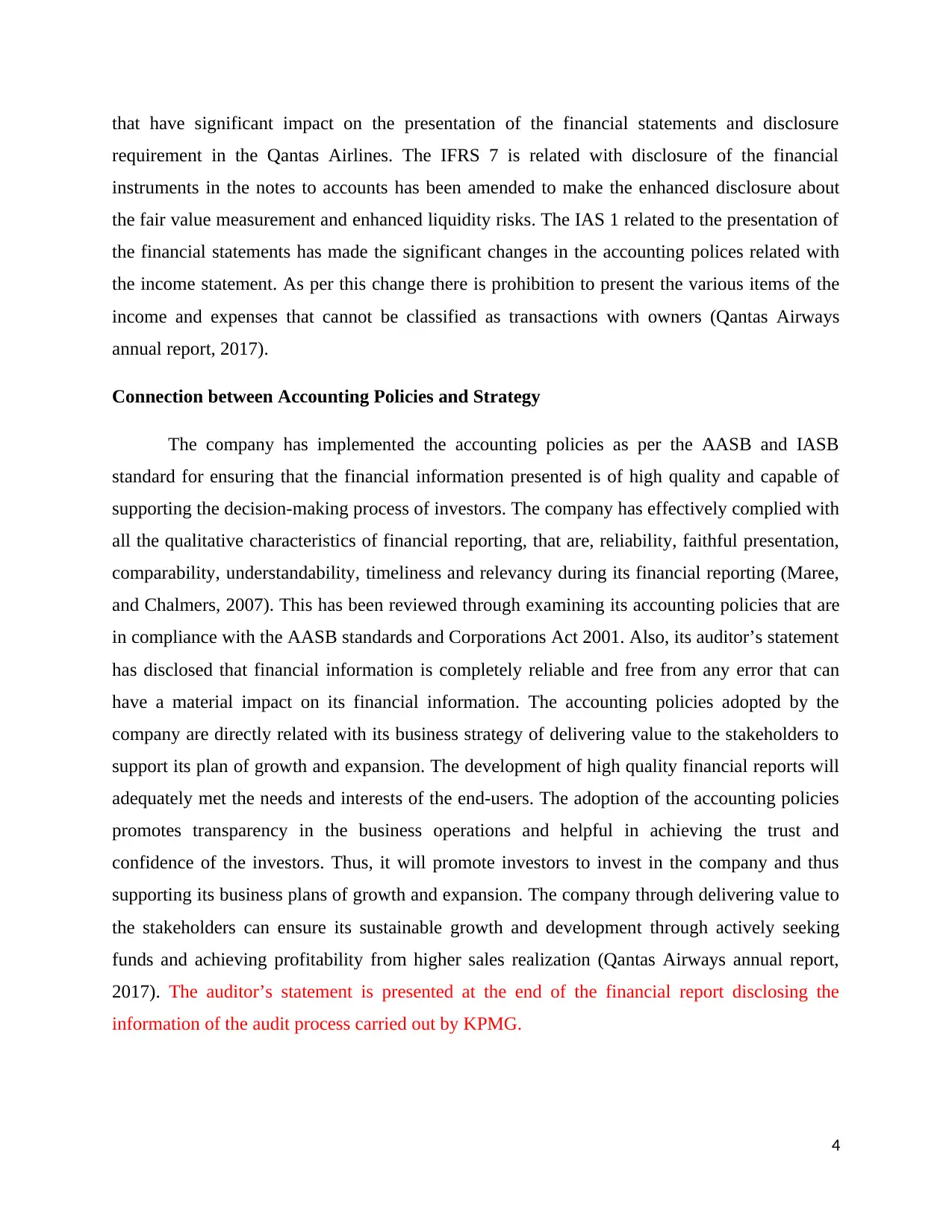
that have significant impact on the presentation of the financial statements and disclosure
requirement in the Qantas Airlines. The IFRS 7 is related with disclosure of the financial
instruments in the notes to accounts has been amended to make the enhanced disclosure about
the fair value measurement and enhanced liquidity risks. The IAS 1 related to the presentation of
the financial statements has made the significant changes in the accounting polices related with
the income statement. As per this change there is prohibition to present the various items of the
income and expenses that cannot be classified as transactions with owners (Qantas Airways
annual report, 2017).
Connection between Accounting Policies and Strategy
The company has implemented the accounting policies as per the AASB and IASB
standard for ensuring that the financial information presented is of high quality and capable of
supporting the decision-making process of investors. The company has effectively complied with
all the qualitative characteristics of financial reporting, that are, reliability, faithful presentation,
comparability, understandability, timeliness and relevancy during its financial reporting (Maree,
and Chalmers, 2007). This has been reviewed through examining its accounting policies that are
in compliance with the AASB standards and Corporations Act 2001. Also, its auditor’s statement
has disclosed that financial information is completely reliable and free from any error that can
have a material impact on its financial information. The accounting policies adopted by the
company are directly related with its business strategy of delivering value to the stakeholders to
support its plan of growth and expansion. The development of high quality financial reports will
adequately met the needs and interests of the end-users. The adoption of the accounting policies
promotes transparency in the business operations and helpful in achieving the trust and
confidence of the investors. Thus, it will promote investors to invest in the company and thus
supporting its business plans of growth and expansion. The company through delivering value to
the stakeholders can ensure its sustainable growth and development through actively seeking
funds and achieving profitability from higher sales realization (Qantas Airways annual report,
2017). The auditor’s statement is presented at the end of the financial report disclosing the
information of the audit process carried out by KPMG.
4
requirement in the Qantas Airlines. The IFRS 7 is related with disclosure of the financial
instruments in the notes to accounts has been amended to make the enhanced disclosure about
the fair value measurement and enhanced liquidity risks. The IAS 1 related to the presentation of
the financial statements has made the significant changes in the accounting polices related with
the income statement. As per this change there is prohibition to present the various items of the
income and expenses that cannot be classified as transactions with owners (Qantas Airways
annual report, 2017).
Connection between Accounting Policies and Strategy
The company has implemented the accounting policies as per the AASB and IASB
standard for ensuring that the financial information presented is of high quality and capable of
supporting the decision-making process of investors. The company has effectively complied with
all the qualitative characteristics of financial reporting, that are, reliability, faithful presentation,
comparability, understandability, timeliness and relevancy during its financial reporting (Maree,
and Chalmers, 2007). This has been reviewed through examining its accounting policies that are
in compliance with the AASB standards and Corporations Act 2001. Also, its auditor’s statement
has disclosed that financial information is completely reliable and free from any error that can
have a material impact on its financial information. The accounting policies adopted by the
company are directly related with its business strategy of delivering value to the stakeholders to
support its plan of growth and expansion. The development of high quality financial reports will
adequately met the needs and interests of the end-users. The adoption of the accounting policies
promotes transparency in the business operations and helpful in achieving the trust and
confidence of the investors. Thus, it will promote investors to invest in the company and thus
supporting its business plans of growth and expansion. The company through delivering value to
the stakeholders can ensure its sustainable growth and development through actively seeking
funds and achieving profitability from higher sales realization (Qantas Airways annual report,
2017). The auditor’s statement is presented at the end of the financial report disclosing the
information of the audit process carried out by KPMG.
4
Paraphrase This Document
Need a fresh take? Get an instant paraphrase of this document with our AI Paraphraser
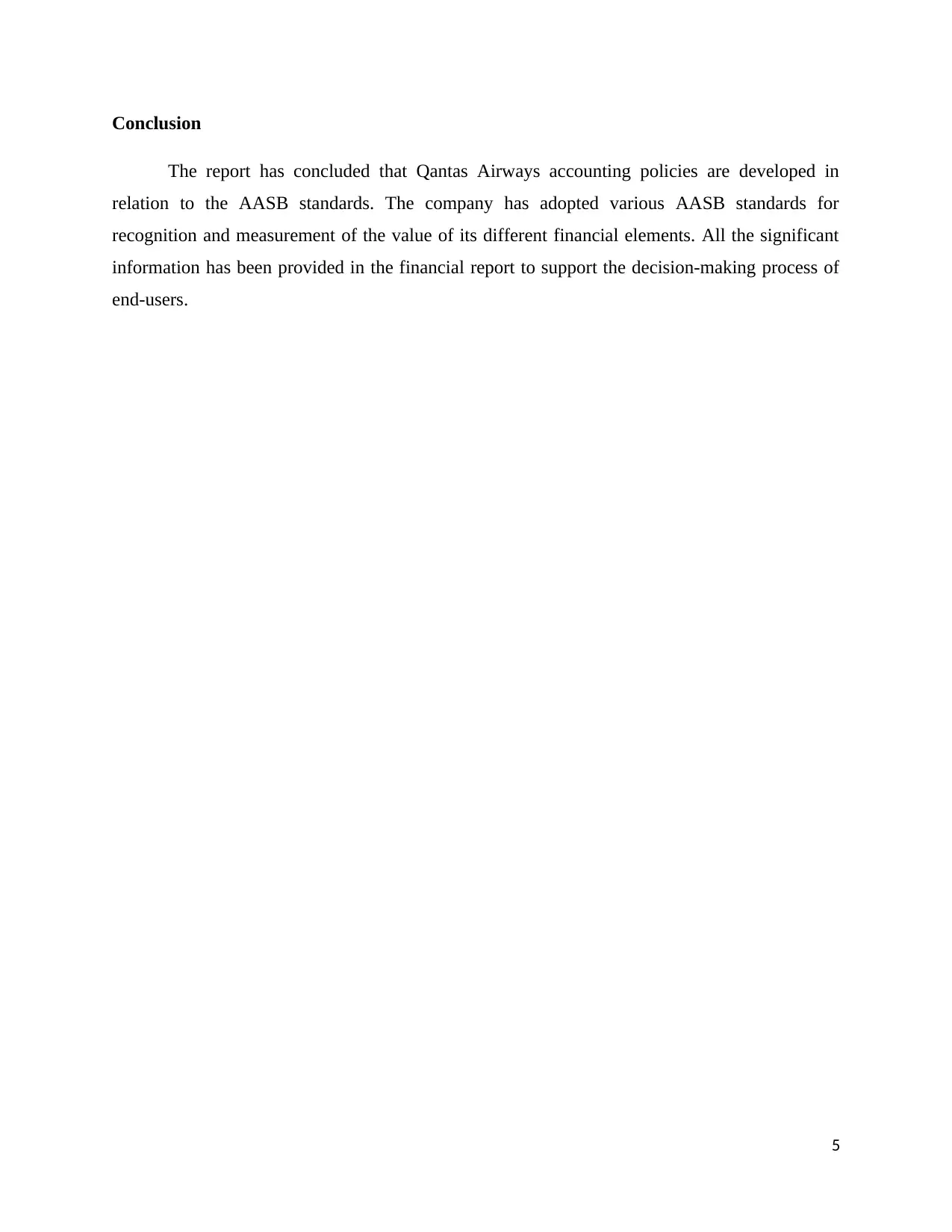
Conclusion
The report has concluded that Qantas Airways accounting policies are developed in
relation to the AASB standards. The company has adopted various AASB standards for
recognition and measurement of the value of its different financial elements. All the significant
information has been provided in the financial report to support the decision-making process of
end-users.
5
The report has concluded that Qantas Airways accounting policies are developed in
relation to the AASB standards. The company has adopted various AASB standards for
recognition and measurement of the value of its different financial elements. All the significant
information has been provided in the financial report to support the decision-making process of
end-users.
5
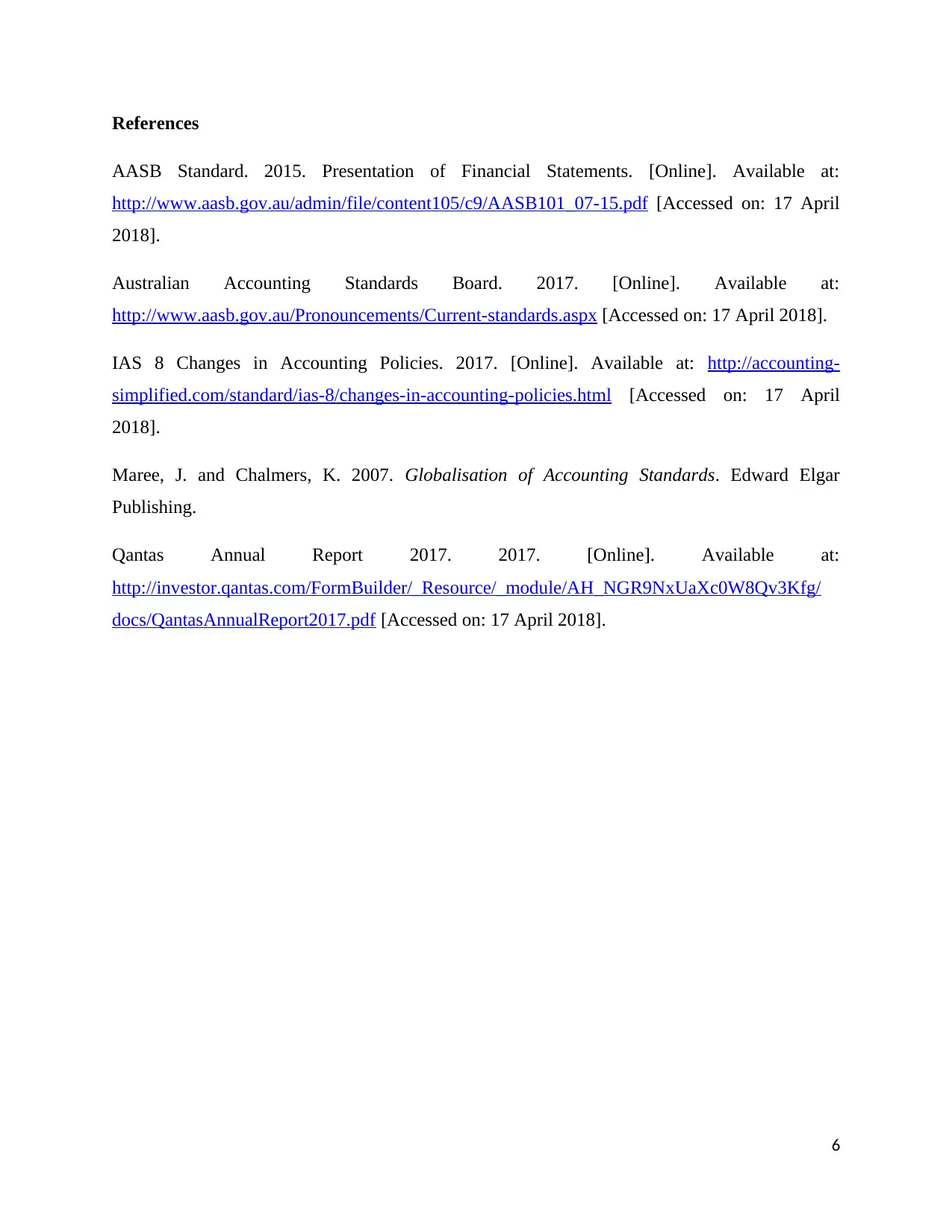
References
AASB Standard. 2015. Presentation of Financial Statements. [Online]. Available at:
http://www.aasb.gov.au/admin/file/content105/c9/AASB101_07-15.pdf [Accessed on: 17 April
2018].
Australian Accounting Standards Board. 2017. [Online]. Available at:
http://www.aasb.gov.au/Pronouncements/Current-standards.aspx [Accessed on: 17 April 2018].
IAS 8 Changes in Accounting Policies. 2017. [Online]. Available at: http://accounting-
simplified.com/standard/ias-8/changes-in-accounting-policies.html [Accessed on: 17 April
2018].
Maree, J. and Chalmers, K. 2007. Globalisation of Accounting Standards. Edward Elgar
Publishing.
Qantas Annual Report 2017. 2017. [Online]. Available at:
http://investor.qantas.com/FormBuilder/_Resource/_module/AH_NGR9NxUaXc0W8Qv3Kfg/
docs/QantasAnnualReport2017.pdf [Accessed on: 17 April 2018].
6
AASB Standard. 2015. Presentation of Financial Statements. [Online]. Available at:
http://www.aasb.gov.au/admin/file/content105/c9/AASB101_07-15.pdf [Accessed on: 17 April
2018].
Australian Accounting Standards Board. 2017. [Online]. Available at:
http://www.aasb.gov.au/Pronouncements/Current-standards.aspx [Accessed on: 17 April 2018].
IAS 8 Changes in Accounting Policies. 2017. [Online]. Available at: http://accounting-
simplified.com/standard/ias-8/changes-in-accounting-policies.html [Accessed on: 17 April
2018].
Maree, J. and Chalmers, K. 2007. Globalisation of Accounting Standards. Edward Elgar
Publishing.
Qantas Annual Report 2017. 2017. [Online]. Available at:
http://investor.qantas.com/FormBuilder/_Resource/_module/AH_NGR9NxUaXc0W8Qv3Kfg/
docs/QantasAnnualReport2017.pdf [Accessed on: 17 April 2018].
6
⊘ This is a preview!⊘
Do you want full access?
Subscribe today to unlock all pages.

Trusted by 1+ million students worldwide
1 out of 6
Related Documents
Your All-in-One AI-Powered Toolkit for Academic Success.
+13062052269
info@desklib.com
Available 24*7 on WhatsApp / Email
![[object Object]](/_next/static/media/star-bottom.7253800d.svg)
Unlock your academic potential
Copyright © 2020–2025 A2Z Services. All Rights Reserved. Developed and managed by ZUCOL.





